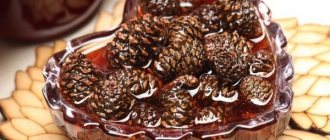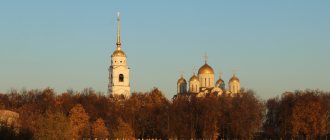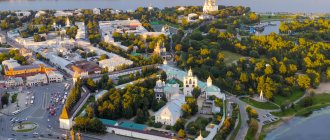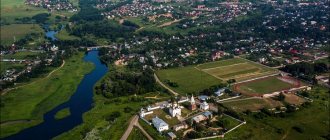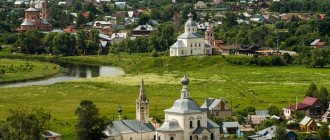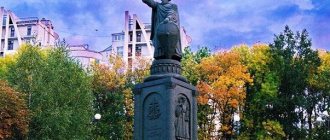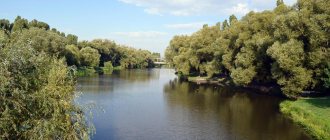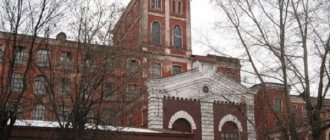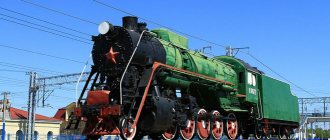The city of Klin, located 65 kilometers from the Moscow Ring Road, celebrated its 700th anniversary in 2021. It has a rich history, the interest of which attracts not only Russian, but also foreign tourists. If you live in Moscow or its immediate surroundings, you should definitely visit this city: you don’t have to devote a lot of time to sightseeing, a weekend or even one day is enough. Arriving in the morning, you will have time to see all the interesting places and return home before the metro closes.
Train Station
It is the first thing that city guests who arrive by train see. Rail transport to Klin is very popular: every day thousands of people leave here to study or work in the capital. The city is connected to the Leningradsky Station in Moscow by an hour's journey by Lastochka, or approximately 1 hour and 40 minutes by regular train.
Klinsky Station is one of the oldest in Russia and was built in the mid-19th century. There was a fortunate coincidence for the townspeople: the engineer, under whose leadership the construction of the building was carried out, mixed up the drawings, giving the district Klin a first class station intended for the provincial town.
By the way, there is a bus station nearby, from where you can go to Moscow by bus (route No. 437 goes to the Vodny Stadion metro station).
Train station address: Karl Marx Street, building 2.
Christmas tree decorations museum
The Klin Compound Museum was opened in 2008 and over the short period of its existence has become very popular: during the “high” winter season, excursions, Christmas trees and even wedding programs are scheduled here for months in advance. Therefore, if your trip took place during the warm season, this will most likely turn out to be a plus, since it will allow you to enjoy the exhibition in a small company. The most impressive part of the visit is seeing the work of the glassblower and artist who make the Christmas tree decorations right in front of visitors. And if you yourself have a love for creativity, be sure to attend a master class: from it you will take away a ball painted with your own hands.
Don’t forget to check out the museum’s store: original handmade balls purchased here will be an excellent souvenir for your loved ones.
Address of the Klinsky Compound: Staroyamskaya street, 4.
Opening hours: daily, except Mondays, from 9:00 to 17:30 (ticket office until 16:30).
Gaidar House-Museum
Arkady Gaidar lived in Klin for a relatively short time: only three years. However, this period turned out to be very fruitful: it was here that he wrote such famous works as “Timur and His Team” and “The Fate of the Drummer.” The house-museum stores many of Gaidar’s personal belongings, books, photographs, documents, as well as various household items related to his life and work. Visitors can take excursions and watch videos based on the writer’s works.
Address: Gaidara street, building 17. Opening hours: Wednesday, Saturday, Sunday - from 9 to 18, Thursday, Friday: from 9 to 19.
Closed: Monday, Tuesday, last Friday of each month.
Shopping arcades and the “Mycelium Girl” fountain
The ancient shopping arcades were built at the end of the 19th century. They are a talented execution of the project of the architect Rodionov in the pseudo-Russian style. The buildings suffered from both major fires and Nazi attacks, but were quite well preserved. But the recent restoration, according to many old-timers, has deprived the cultural monument of a significant part of its former charm. By the way, this is not only a place for photo shoots for tourists, but also fully functioning retail premises, so by visiting them you can combine a pleasant walk with shopping.
Very close to the shopping arcades there is the Mycelium Girl fountain, one of the main symbols of the city. The history of perpetuating the image of a charming peasant woman with a basket of mushrooms, wringing out a rain-soaked dress, began in the middle of the 19th century. It was then that it was created from Kasli cast iron by the architect Kamensky, commissioned by the owner of the Zolino estate located near Klin. The sculpture is a symbol of a touching family story. When the eldest son of the owner of the estate, Dmitry, was walking through the forest after a thunderstorm, he saw under a spruce tree a girl of about eight years old, who was wet and shivering from the cold. Dmitry took the baby to his home, treated her to hot tea, and when she warmed up, he took her to the village. In the summer, children run around the fountain every now and then, not at all afraid of getting wet.
Address: Sovetskaya square, 1a-1b.
Historical roots of the city of Klin
The chronicle itself, telling about the date of origin of Klin, has not been preserved. But from the Nikon Chronicle, historians learned that it really existed. In 1240, on the site of the city there was a settlement in which people from the Golyad tribe lived. The wedge served as a border fortification.
The founding date of the city is considered to be 1317. According to the version of the Russian historian Vasily Tatishchev, the name of the city came from its geographical location, since it was located in a “narrow bow” near the Sestra River.
Ancient Klin looked like a large wooden fortress located on a hill. It was surrounded by high walls and washed by the waters of the full-flowing Sestra River, along which ships with furs, grain, leather and fabric products, and wood moved.
The city was in a favorable location. Not only the land route, but also the Moscow-Veliky Novgorod waterway passed through it. This attracted the attention of Russian princes. The inhabitants of the fortress had to repeatedly repel attempts by enemies to capture it. Prince Yuri of Moscow even teamed up with the Suzdal prince and the Tatar hordes to storm Klin along with other cities: Kostroma, Pereyaslavl, Dmitrov.
The residents had to endure difficult trials during the reign of Ivan the Terrible, who gave the city to the guardsmen. The time has come for robberies, emptying peasants' barns, and stealing livestock. Therefore, many of them gave up land ownership. Since that time, there has been an increase in the development of crafts and active deforestation. Klin wood was famous for its extraordinary properties. It was floated down the river even to Moscow for the construction of Kremlin buildings. After the death of the sovereign, the Romanov family began to rule the city.
In 1781 Klin became a district town. According to Peter I, the status of the residents was coachmen. Postal business and transportation are their main occupations. Even the city's coat of arms depicts a postman riding a horse.
Shopping arcades appeared in the city, which have survived to this day.
You can view them once you get to Sovetskaya Square. The buildings occupy an entire block.
Many people passed through Klin. To satisfy their needs, inns, shops, warehouses, and wine cellars are opened.
Built:
- mayor's house;
- almshouse;
- postal yard, consisting of a brick 2-story building and two one-story houses with sheds for horses and a stable.
With the opening of the railway line in 1851, transportation by coachmen decreased, and the number of hotels and inns decreased. People had to master a new industry - weaving. They started making scarves, upholstery fabrics for furniture, and muslin.
The city center has shifted to Cathedral Square with shopping arcades and hotels.
Old town shopping area
In November-December 1941, the city was occupied by the Germans for less than a month, but it had to be restored again.
The lives of many scientific and cultural figures are connected with Klin. Dmitry Mendeleev lived for more than 40 years in the Boblovo estate, where he conducted experiments in the established laboratory. Famous artists visited him: Shishkin, Kuindzhi, Yaroshenko.
In 1887, Mendeleev ascended in a balloon to a height of 3 km to observe a solar eclipse. Moreover, he did this on his own without an aeronaut. He had to troubleshoot at height from a wind-tangled rope.
Quite a few other prominent families are mentioned in connection with Klin or nearby places:
- Leo Tolstoy visited relatives who lived in the village of Sogolevo. The story “Three Deaths” was born in this area.
- The following people worked in the city: writer, naturalist Mikhail Prishvin (in the green plant nursery), academician Timiryazev.
- The artist Vasnetsov visited Klin to work on sketches.
- The names of composer Pyotr Tchaikovsky, sculptor Vera Mukhina, poet Alexander Blok, and writer Arkady Gaidar are associated with the same city.
Silence, sparse population, magnificent landscapes seduced Pyotr Ilyich Tchaikovsky. He chose the village of Maidanovo as his place of residence. I enjoyed walks in the forest and drew creative inspiration from them. Later he moved to the Frolovskoye estate, then to Klin, where he rented a house from a justice of the peace. After the composer's death, his nephew bought this house.
Now it is a city of regional subordination. If in 1897 just over five thousand people lived in it, then by 2009 the population reached 80.9 thousand people. The city has a railway station and a military airfield.
Getting from Moscow to Klin is very fast. A distance of 70 km is covered in 1-1.5 hours.
5. Military Glory Memorial and Sorrow Church
At the end of 1941, Klin was occupied by German troops for 23 days. Of course, these days left a huge mark on the history of the city, and the contribution of the residents to the victory was not forgotten: Klin was awarded the title “city of military valor,” and in the very center of the city there is a memorial with a military cemetery and an Eternal Flame. Not far from the Memorial is the Sorrow Church, built in 1861. Now this is the main temple of Klin. The memorial is located at the intersection of Gagarin and Pervomaiskaya streets.
Church address: Liteinaya street, 9.
Shop under the clock
A curious architectural monument of the 19th century is the “shop under the clock”. Otherwise it is called Mikhailov's house.
It is located on Lenin Street, 21 at the intersection with Liteinaya Street, 1.
There is a clock on the turret of a 2-story red brick house. They did not appear immediately, but only in 1924, as a symbol of the new socialist era.
The building was owned by the merchant Mikhailov. It housed a teahouse and a tavern. Then in 1925 Torgsin appeared - a store in which goods were sold only for currency and gold. Residents went to it as if it were a museum - to look at expensive goods, the shelves were full of them.
During the war, many houses were destroyed. And the remaining buildings were converted into dormitories. A dormitory was first organized in this house, then work was carried out to change the internal layout and create communal apartments. Later, a clothing and discount goods store appeared on the ground floor. It was replaced by dairy products and products. Since 1977, the second floor has been occupied by the architecture department.
Sestroretsky and Demyanovsky parks
Sestroretsky Park is a favorite vacation spot for city residents and families in the summer. There is an open-air cinema, boat and catamaran rentals, attractions, bike paths, playgrounds for children, skaters and even dogs. In winter, there is also a wonderful atmosphere here: the lanterns are on, the kids are riding the slides... The only drawback of the park, the residents of Clinch say its popularity: sometimes it seems that the whole city is gathering here.
To get to Demyanovsky Park from Sestroretsky, cross the bridge over the river and then turn right. In the summer, this is not the first year that this place has been delighting residents and guests of Klin with wonderful flower arrangements: at first the city was the site of a flower festival, at which masterpieces of landscape design were presented by different districts of the Moscow region, and then this tradition took root at the local level. In addition, the park has historical value. The Demyanovo estate has been known since 1641; at various times, the Golitsyn princes, the Naumov nobles lived here (with whom Catherine II even stayed once), the family of public figure V.I. Taneyeva. From 1903 to 1917, artist A.M. spent almost every summer here. Vasnetsov, loved to visit Demyanov and Andrei Bely. Now the estate is under restoration.
But the Demyanovskaya Church has already been restored. Next to it there is a small chapel built right on the pond, and on January 19 a font will be organized on the same pond.
Park addresses: st. Mira, Sestroretsky Park; Taneyev passage area, Demyanovsky park.
Assumption Church
The Church of the Assumption of the Blessed Virgin Mary is the oldest architectural structure in the city. Until the mid-18th century, it served as the cathedral of a convent.
In 1569, the guardsmen of Ivan the Terrible carried out reprisals against the residents of Klin following a denunciation of their treason. The result is destroyed and burned houses, dead people. According to one legend, the guardsmen were looking for the gold of the merchant Velyaminov from Novgorod, buried in an underground passage. However, their searches were unsuccessful.
In memory of the dead people, residents erected the Assumption Church in 1572
You can visit it today.
There are three versions about the creation of this church:
- Ivan the Terrible was overcome by repentance, and he allocated money for the construction of a church.
- The temple was built at the expense of the townspeople.
- The king allocated funds so that during his campaigns he would have a place to visit.
In the same temple, the future Emperor Peter I, the baby of Tsar Alexei Romanov, was baptized. Tchaikovsky attended services there.
The relics that have survived to this day are the icons of Sergius of Radonezh and the Tikhvin Mother of God.
The church was restored in 1962-1967 with donations from a Belgian princess who came to see the Tchaikovsky Museum. However, believers received the temple only in 1992. A belfry was added next to it, since the previous one was blown up in 1931. It was re-consecrated in honor of Sergius of Radonezh, but many residents call it by its old name - Uspensky.
The church is located at Papivina Street, 16a.
House-Museum of P.I. Tchaikovsky
Tchaikovsky lived in Klin and its environs since 1885: he rested, walked a lot, led an active social life and, of course, worked fruitfully. It was in the Klin “shelters” (as the composer himself called the houses he rented) that the opera “The Queen of Spades”, the ballets “Sleeping Beauty”, “The Nutcracker”, the Fifth and Sixth Symphonies, as well as many other works known to connoisseurs of classical music were created. The museum has existed for more than a hundred years and is recognized as the oldest memorial museum in Russia. But, despite its advanced age, cultural life does not stop here: the concert hall hosts exhibitions, concerts, conferences and festive events throughout the year, and the composer’s house itself is available for excursions by appointment and independent inspection.
The house-museum is open to visitors on Monday, Tuesday, Friday, Saturday and Sunday from 10.00 to 18.00. The last Monday of every month is sanitary day. Address: Tchaikovsky street, 48.
Houses with their own history
In the center of Klin there are houses that look like they were in ancient times. The alterations affected them only indoors.
House of Mayor Konstantin Reka
Looking at this modest one-story building, it’s hard to believe that it once held the lead in luxury in the city. The decoration of the main facade is the arched niche of the attic window.
The mayor had many rights. The police were under his command. He tried violators with minor acts, and dealt with government and military affairs.
Konstantin Reka was distinguished by his cordiality and hospitality. He always had guests, there were receptions, balls, dinners.
The house is now occupied by a public organization.
The building of the first city pharmacy is distinguished by its originality - unusual architecture in the Art Nouveau style.
The former owner is the owner of a glass factory, the assortment of which included glass equipment for medical organizations and packaging for medicines. There was a pharmacy on the bottom floor of his house.
The original appearance of the building has been preserved, but the interior layout and decoration have been changed.
The postal yard does not have any originality in the project.
At that time, such structures were built according to one type - a regular closed quadrangle.
Postal yard
The complex includes: a main 2-story building and two one-story office buildings.
The building went down in history for two reasons:
- Radishchev mentioned it in “Journey from St. Petersburg to Moscow,” describing the concert of a blind singer who was listening.
- During the Germans' assault on Klin, Marshal Rokossovsky negotiated with the Kremlin from a room in this house.
The appearance of the former girls' gymnasium clearly shows a pseudo-Gothic style.
Its construction was carried out using city funds and donations from citizens. In it, in addition to 7 grades, girls could complete an additional special eighth grade and receive the title of home teacher. Children from an ordinary working-class family could not study at the gymnasium due to the lack of necessary funds. This opportunity was provided to merchants, nobles' daughters and children of manufacturers and clergy.
Maidanovsky Park
Previously an ancient village (it was owned by the Naryshkins since the 16th century), Maidanovo is now located within the city. The real pearl of this place is a park with a pond in which white and black swans swim. Even on weekends, it’s usually not very crowded here (especially compared to Sestroretsk Park), so if you’re in the mood for a walk, relaxing in a quiet environment, feel free to choose Maidanovo to complete your walking tour of Klin. By the way, if you're lucky, here you can meet not only swans, but also squirrels.
Address: Maidanovo microdistrict, Maidanovsky Park.
A busy walk, during which you can see all the listed attractions, will take you the whole day. However, it will be such a busy and interesting day that perhaps you will leave the city of Klin with the desire to return to it again.
Ekaterina Koroleva
